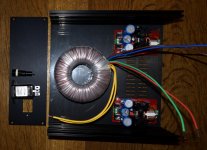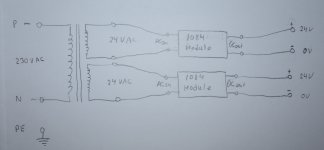I am building 24 VDC regulated PSUs for preamp use in the moment and need some good advice for using the chassis for "grounding" on 24 DC side. One PSU chassis consist of one trafo with 2 x 24 VAC outputs. Each 24 VAC output goes to a 1084 regulator based module and output of each is 24 VDC (can be adjusted). I will build two of those as I have four 1084 modules (so two chassis). I want a flexible PSUs so I can either configure each PSU chassis as:
2 x 24 VDC (individual without any galvanic connection)
1 x 48 VDC
1 x +-24 VDC
…..all depending on where I define the voltage reference (virtual zero point). There will be four electrical isolated banans at the front. The question is if I can let the chassis float or it will be better to be able to wire the "virtual zero point" to the chassis depending on the configuration so I should add an extra banana which is connected to the chassis so I can use this connection to either make a galvanic connection or via a film capacitor?
A couple of pictures attached which shows what I am building.
2 x 24 VDC (individual without any galvanic connection)
1 x 48 VDC
1 x +-24 VDC
…..all depending on where I define the voltage reference (virtual zero point). There will be four electrical isolated banans at the front. The question is if I can let the chassis float or it will be better to be able to wire the "virtual zero point" to the chassis depending on the configuration so I should add an extra banana which is connected to the chassis so I can use this connection to either make a galvanic connection or via a film capacitor?
A couple of pictures attached which shows what I am building.
Attachments
OK.....thank you….I will get some CL-60 and add an extra isolated banana and make a connection to the chassis via a CL-60. Then I can make a jumper from the zero point to that banana.
Yes, those Pete Millett boards was for 5V filament supply for a 300B tube amp but I found another solution by using Rod Coleman regulators. Then I asked Pete Millett for some suggestions for components to make it a 24V supply.
Yes, those Pete Millett boards was for 5V filament supply for a 300B tube amp but I found another solution by using Rod Coleman regulators. Then I asked Pete Millett for some suggestions for components to make it a 24V supply.
The other way around: there are disadvantages. Your PE may have noise on it, which will then be transferred to the chassis. The chassis also acts as a Faraday cage which nulls out the electrostatic fields inside the cage by producing the opposite field on the cage itself. You don't want that in your audio ground either.
That's why you "lift" your audio ground above your PE/chassis ground with the CL-60.
That's why you "lift" your audio ground above your PE/chassis ground with the CL-60.
You do however need a 5th banana which is PE/chassis ground going to your preamp chassis.
If you have a failure in your power supply that raises one of the rails to the AC mains, then that voltage is going to your preamp, so its chassis also needs to be tied to protective earth.
If you have a failure in your power supply that raises one of the rails to the AC mains, then that voltage is going to your preamp, so its chassis also needs to be tied to protective earth.
I will add a 5th banana. Then I can always choose what to do with it but the thermistor solution seems fine. Instead of CL-60 "RS Component" has this (among many):
B57364S0100M000 | EPCOS Termistor, 10Ω +-20% Tolerance, 5100mW, For Blod motorstart, switch-mode stromforsyning, 100s, 21 (Dia.) x 7mm | RS Components
It should do the same "job"? …...it is also a 10 ohm NTC type which can handle some current.
B57364S0100M000 | EPCOS Termistor, 10Ω +-20% Tolerance, 5100mW, For Blod motorstart, switch-mode stromforsyning, 100s, 21 (Dia.) x 7mm | RS Components
It should do the same "job"? …...it is also a 10 ohm NTC type which can handle some current.
Ok.....so chassis which only has the preamp inside and will only have the +-24V and virtual Gnd from the PSU also need the PE connection to chassis even that no main (230 VAC) voltage goes to the preamp chassis? …...it that if a theoretical error occurs so 230 VAC goes via the low voltage regulated outputs......or it is because +- 24 VDC (48 VDC) is considered "lethal"? ….or both?
The "funny" thing is that I have no PE in the outlets in my living room…...but still like to make things right...….
The "funny" thing is that I have no PE in the outlets in my living room…...but still like to make things right...….
48 VDC could be lethal, but not at the currents we're talking about. It's in case of a failure which delivers 230VAC on one of the outputs.
I was pretty lackadaisical about 3-prong outlets when I lived in the States, but I don't think I would be in a 230 VAC mains country. While you're at it, fix those outlets too!
I was pretty lackadaisical about 3-prong outlets when I lived in the States, but I don't think I would be in a 230 VAC mains country. While you're at it, fix those outlets too!
The PE in the living room has been on my whish list.....
I also sometimes use my 300B amp which runs with 550 VDC and with 420 VAC from the trafo. 900 uF and 550 VDC can "do something"...….at least a burn mark. It is a bad smell of burned meat….so I have seen and smelled what happens…...but it was not my "meat"….or my amp.....it was a capacitor in a flash....so "only" about 400 VDC and 220 uF.
I also sometimes use my 300B amp which runs with 550 VDC and with 420 VAC from the trafo. 900 uF and 550 VDC can "do something"...….at least a burn mark. It is a bad smell of burned meat….so I have seen and smelled what happens…...but it was not my "meat"….or my amp.....it was a capacitor in a flash....so "only" about 400 VDC and 220 uF.
- Status
- This old topic is closed. If you want to reopen this topic, contact a moderator using the "Report Post" button.
- Home
- Amplifiers
- Pass Labs
- Building 24V PSU for preamp use

